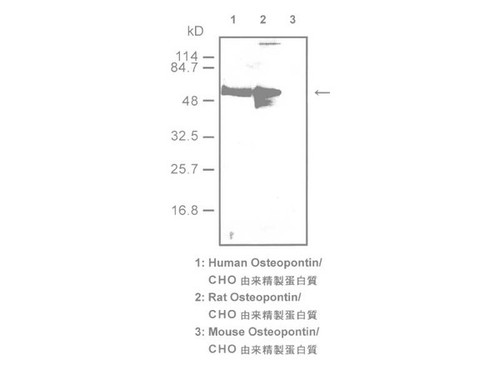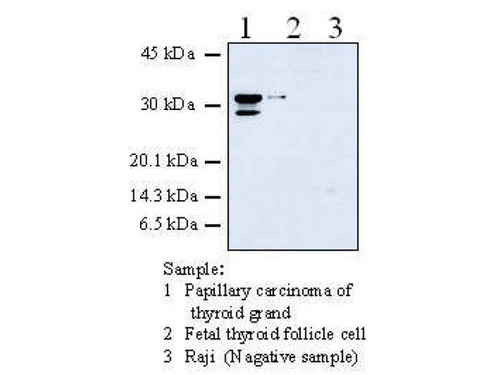-

Anti-Osteopontin N-Half (34E3) Mouse IgG MoAb 1
Osteopontin (OPN) is a secreted glycoprotein that was originally isolated from bone. Its molecular weights have been reported in the range of 66 kDa to 44 kDa depending on glycosylation and phosphorylation. OPN is also known to be expressed in other...
Add to Cart$136.00 -

Osteopontin (1B20) Anti-Human Mouse IgG MoAb 1
Osteopontin (OPN) is a secreted glycoprotein that was originally isolated from bone. Its molecular weights have been reported in the range of 66 kDa to 44 kDa depending on glycosylation and phosphorylation. OPN is also known to be expressed in other...
Add to Cart$136.00 -

ORP150 (Oxygen Regulated Protein, p150) (2F07) Anti-Human Mouse IgG MoAb 1
Heat shock proteins (HSPs)/stress proteins are molecular chaperones that are induced by various environmental and physiological stimuli. The 150-kDa oxygen-regulated protein (ORP150), a new member of HSP family, functions as a molecular chaperone in the...
Add to Cart$136.00 -

OGG1 (7E2) Anti-Human Mouse IgG MoAb 1
Oxidative damage to DNA has been proposed to have a role in cancer and ageing. Oxygen-free radicals formed during normal aerobic cellular metabolism attack bases in DNA, and 7, 8-dihydro-8-oxoguanine (8-oxoG) is one of the adducts formed. Eukaryotic...
Add to Cart$136.00 -

Occludin (1A8) Anti-Rat Mouse IgM MoAb 1
Occludin is an approximately 60kDa-integral membrane protein localizing at Tight-Junction, and composed of short N-terminal cytosolic domain, four transmembrane domains and long C-terminal cytosolic domain. It is reported that Occludin has no homology to...
Add to Cart$136.00 -

Galectin-3 (38B2) Anti-Human Mouse IgG MoAb 1
Galectin is widely distributed in nematodes, insects, and porifers, as well as vertebrates, and it has also been found to be present in true fungi. Galectin does not just occur in the cytoplasm, it is also present in the nucleus, on the cell surface, in...
Add to Cart$136.00 -

Napsin A (TMU-Ad02) Anti-Human Mouse IgG MoAb 1
A new protein isolated by two-dimensional immuno-electrophoresis from tissue of lung adenocarcinoma was identified as Napsin A, a new aspartic Proteinase. The reactivity of the antibody showed immunohistochemically in type II pneumocytes, alveolar...
Add to Cart$136.00 -

Anti-mTOR (N5D11) Mouse IgG MoAb 1
Rapamycin is a lipophilic macrolide compound and induces a G1 phase growth arrest in S. cerevisiae and mammalian cells. The mammalian target of rapamycin (mTOR) has a molecular weight of 290 kDa and a Ser/Thr protein kinase activity. mTOR has been shown...
Add to Cart$136.00 -

MDMX (77A1) Anti-Human Mouse IgG MoAb 1
The p53 tumor suppressor protein is stabilized in response to cellular stress, resulting in activation of genes responsible for either cell cycle arrest or apoptosis. The cellular pathway for releasing normal cells from p53- dependent cell cycle arrest...
Add to Cart$136.00 -

MCP-1 Anti-Rat Mouse IgG MoAb 1
Human macrophage/monocyte chemotactic and activating factor (MCAF) also called human macrophage chemoattractant protein-1 (MCP-1) is an 8.6 kDa protein containing 76 amino acid residues. It plays an important role in the inflammatory response of blood...
Add to Cart$136.00 -

MBD3 (Methyl-CpG-Binding Protein 3) (3A3) Anti-Human Mouse IgG MoAb 1
Methylation at CpG dinucleotides in genomic DNA is a fundamental epigenetic mechanism of gene expression control in vertebrates. Proteins with a methyl-CpG binding domain (MBD) can bind to single methylated CpGs and most of them are involved in...
Add to Cart$136.00 -

KGF (8A4) Anti-Human Mouse IgG MoAb 1
Keratinocyte Growth Factor (KGF) is a growth factor which affects epithelial cells specifically and it hardly affects mesenchymal cells like fibroblasts. Its receptor is K-sam, and it is said that the signals of differentiation and proliferation will be...
Add to Cart$136.00

Monoclonal Antibodies
Monoclonal antibodies (mAb or moAb) are derived from a single B-cell parent clone and therefore only recognize a single epitope per antigen.
These B-cells are immortalized by fusion with hybridoma cells, allowing for long-term generation of identical monoclonal antibodies.
Monoclonal antibodies specifically detect a particular epitope on the antigen and therefore are less likely than polyclonal antibodies to cross-react with other proteins.
IBL-America offers a wide range of monoclonal antibodies that can be used in the research and development of multiple laboratory testing applications.
